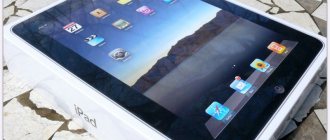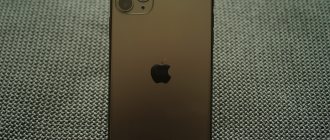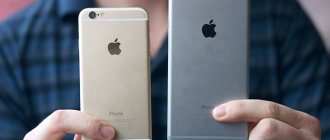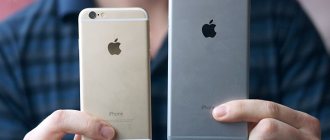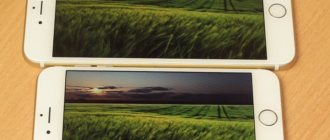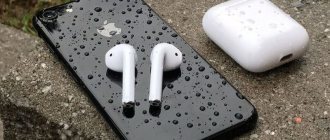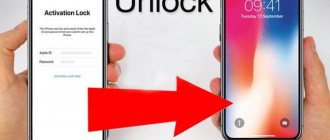Why iPhone 6 is already dead
It has always been touching how owners of previous generations of iPhones refuse to update, explaining this by the sufficient performance of the old model.
Six months later they sing another song. You, the owners of sixes, will also sing.
The iPhone 6 had 1 gigabyte of RAM, which was not enough for some tasks even then. This was the Achilles heel that sealed his fate. Applications restarted, crashed at startup, the Internet browser “forgot” tabs at the first opportunity, sometimes taking half a minute to open. I wouldn’t be surprised if the lion’s share of iOS 8 and 9 bugs is due to a lack of RAM.
This was an experiment to sell us yesterday’s hardware under the guise of new, which for the first time crossed the line of what was permitted. And if the unsuccessful but amazing iPad 3 was an attempt to release a breakthrough product, then the iPhone 6 was an attempt to sell old stuff .
Today 6s took its place. It doesn't have the problems of the previous model. There isn't a single one left. And there are 2 gigabytes of RAM . They are the ones who change everything.
iPhone XR operating time
As usual, we open the Apple website and see this wonderful inscription: “iPhone XR lasts up to 1.5 hours more than iPhone 8 Plus.”
If you remember the “plus eight”, then it really held a charge quite well. And here we are promised even more! Victory? Depending on which way you look at it...
Judging by user reviews, the battery life of the iPhone XR is really not the worst. But! There is still no need to say that it holds a charge much better than the iPhone 8 Plus (that’s what the phrase “up to 1.5 hours longer” makes you think).
About the same? Yes. Much longer? No.
However, as we remember, a lot depends on the use case.
For example, if you listen to music on headphones, the iPhone XR will easily work for a couple of days.
But who does that? Almost no one.
Live Photo. Stand straight
According to Apple, this mode should “breathe” life into static photos, adding context to them. Each photo on the iPhone 6s can become “live”; to do this, you just need to press the button at the top in shooting mode. For convenience - five points.
I, like most first-time iPhone 6s owners, have a number of complaints about how Live Photo works.
First of all , Live Photo subjectively has nothing in common with video . The camera takes several photos “before” and “after” when you press the shutter button, which is indicated by the LIVE logo at the top of the screen.
The end result is a slideshow with fairly large “drops” of frames. People twitch, the movement of objects in the frame becomes very sketchy. Yes, I can attribute this moment to personal preferences or even inflated expectations. Maybe I was the only one who thought that the result would be a little “smoother”, more realistic.
Secondly , Live Photo is completely unpredictable and this can fray a lot of nerves for perfectionists and photography lovers. Every time you press the shutter button, iOS itself decides which frames will be included in the mini-slideshow and which will be left out.
Too often these shots are of you adjusting the iPhone in your hands or, conversely, putting it away. Personally, every second Live Photo is “damaged” in this way.
Thirdly , Live Photo always records sound , and this cannot be turned off yet. Sometimes it's great. Sometimes it’s too much. You can still survive this
Sometimes it's great. Sometimes it’s too much. You can still survive this
Fourth and finally, the resulting Live Photo cannot be edited . I’m sure it costs nothing for iOS to save a slightly longer period of time in the smartphone’s memory after shooting. Why isn't this happening? Because the feature is made for marketing, and only then for people.
Most “random” Live Photos are unpleasant to look at: they jerk and contain very little context. To shoot something normal, you need to stand rooted to the spot, count two seconds, press the shutter, then another three seconds - and only then lower the phone. Apple clearly hasn't figured out how to implement frame stabilization in the context of Live Photo and didn't even try to give the user control over the result of the shooting. It's a pity.
We have reached the point where downright inconvenient functions appear in Apple technology, created to increase sales within the target audience. Samsung is probably sitting and wondering how this happened: first they cheated, now they’re cheated 
Performance. How good it is now
Think about it. Do you need technical specifications? Not needed. If a smartphone visually slows down, it doesn’t matter what’s inside. The main thing is different. What do I see as a future owner?
And I see two things. Firstly, I will buy it, and secondly, it flies .
Applications open at lightning speed. Heavy pages load quickly. In a direct comparison with the iPhone 6, we see the “old man” lagging behind by a third , and sometimes by two times. Switching between applications is fast and without waiting for data to load. Game loading times are almost half as long as the old model. This is a supersonic plane.
All this is predictable from year to year, that’s why it’s a “new iPhone”. But now they've added double the RAM . And it turns out to be a bomb.
I open iOS multitasking, scroll through three dozen “windows” of applications - past games, a browser, notes, an alarm clock... At the very end of the “carousel” waits Google Play Music, opened last night. I choose him.
It does not load from scratch - there is no white screen, no spinning “petals” in the status panel. I just immediately start listening to the track.
Miracle. The application remained in RAM even after an evening of active use. This has never happened before.
I open Safari and launch all the sites I read during the day. Just a little more than 15 pieces. I exit the application, write in chats for an hour, play, and so on. I return back to the browser and see that all the tabs are still open and are not overloaded.
That's the beauty of double the RAM. The iPhone now “remembers” much more, and therefore works visually faster and does not force you to wait again. For me personally, this is already enough to put the old “six” aside. She couldn't even hold three tabs normally.
iPhone 8 and 8 Plus operating time on a single battery charge
Considering the fact that the iPhone 8 is practically the same iPhone 7, it would be foolish to count on any kind of maximally increased autonomy compared to the previous model. It is logical to assume that everything will remain at “plus or minus” exactly the same level.
And this is what Apple came up with:
| iPhone 8 | iPhone 8 Plus | |
| Battery capacity | 1821 | 2675 |
| Standby mode | 240 | 384 |
| Talk time | 14 | 21 |
| Listening to music | 40 | 60 |
Agree, not much. The battery capacity has become slightly lower, and all other numbers are similar to the “seven”. However, Apple does not hide the fact that the iPhone 8 holds a charge exactly the same as the iPhone 7. And even directly indicates this in the specifications of the G8.
The only thing is that the iPhone 8 now has fast charging, and for some this may be a decisive factor when choosing a device.
3D Touch. It's still strange and unusual
Let's immediately discard Apple's empty marketing. 3D Touch is the ability to press on the screen. Not just touch, but press as if on a button - and get something special in return.
I'll try to visualize this logic. You too. You can pick up an iPhone 
So, I urgently need to write a message. The iPhone desktop is open.
- I click on the “Messages” application, a menu appears;
- Without letting go, I select the “New message” item;
- I release it and a text input window opens.
- Let's figure out what clicking does in each application;
- We teach action gestures and bring them to automaticity.
Another example of a gesture. I have received several messages, I need to look at them quickly. I put my finger on the desired SMS, press a little - a preview “window” opens. If you release your finger or simply release the pressure, the window will simply close. A couple of seconds about everything.
But if you pull your finger up while the “window” is open, a list of quick actions appears. In the case of Messages, these are commonly used phrases.
Now let's look at the situation: in fact, I only pressed the screen once, but I did several actions at once: I looked at the message, replied to it, and returned to the inbox list. And all this happened through a combination of clicks and gestures.
That's what 3D Touch is all about. It allows you very quickly do what an iPhone owner often needs. The features vary depending on the application, but the system is the same everywhere: tapping turns on a preview, and gestures allow you to take actions with what you're looking at.
Gallery of examples of 3D Touch capabilities:
Pressing is accompanied by tactile feedback - a short knock, not like vibration. There is something similar on different Android smartphones. The recoil makes an ordinary impression and differs little from what competitors have.
Getting used to 3D Touch isn't easy because there's nothing like it on iOS before. Regardless of experience, the process of getting used to a feature can be divided into two stages:
As soon as pressing firmly becomes part of the iPhone owner’s routine, doing basic tasks on a smartphone will become twice as convenient. To make the process go smoothly and without dents, go to Settings -> Accessibility -> 3D Touch and increase the screen sensitivity (you need to select “low”). Lower the threshold for pressing – it is easier to work with new functions. You won't regret it, more details here.
There aren't a lot of apps in the App Store right now that use force pressure to do anything unique or useful. Partly because of this, the function leaves a double impression: you play with it, then forget about it.
You can live without 3D Touch for now.
Two really convenient actions are switching to multitasking mode by swiping hard from the left edge of the screen, and also the ability to quickly view an email. I haven't appreciated the rest yet. And I don't really want to see this on the iPhone 6.
But that’s it for now.
Conclusions and personal experience
Of course, all these are official figures that have a relationship to reality, but rather indirectly.
Therefore, a little personal experience. Almost all models, under moderate load, can easily survive one working day on a full charge. What is meant by moderate load? 1 hour of conversations, 3 hours on the Internet (mobile Internet), 1 hour of games and music, 10-15 SMS messages. By evening, 10-15% of the battery remains. The indicators strongly depend on the signal level of the cellular network; if it is weak, the battery “melts” quite actively.
I would gladly sacrifice an extra millimeter in the thickness of the device in favor of increasing the operating time of the iPhone. I'm interested in your opinion - would you agree to such concessions in design for the sake of autonomy?
PS Like, click on the social media buttons - get +10% to the battery life of your current or future device!
Improved Touch ID sensor. That's it, this is ideal
The subtitle is yellow. And your eyes are round, 5 rubles each. Because you just saw how the next generation Touch ID sensor works. Not even that. Didn't have time to see it.
This is something out of science fiction, to be honest. Not expected. I put my finger on the sensor, and at the same moment the iPhone 6S unlocks. There is no pause. There is not even an understanding that the smartphone is being unlocked. Recognition happens so quickly that you want to stand up and applaud somewhere into the void.
The best illustration of the new sensor's capabilities? When you press the sensor when the screen is off, the iPhone immediately turns on to the desktop. There is no lock screen as such, it just blinks and disappears because the fingerprint is verified so quickly. Convenient, cool, downright cool.
Apple aims: bigger camera, not better
The iPhone 6s camera is now 12-megapixel and shoots in 4K format. This is, of course, great, but it doesn’t affect the actual quality of the images very much. Yes, the picture can now be scaled even better, but you still can’t see any special details on the screen during normal viewing.
iPhone 6s test shot
However, Apple's camera is still a very good camera with a lot of features. In particular, it can conduct high-speed shooting and take animated, so-called “live” photographs. It works very well and is a bit like a GIF animation.
The Retina-Flash function can be considered very practical: the lighting from the screen during selfies simulates a flash and can be very useful for photographing everything that surrounds you. A good thing, since shooting in the dark without flash is not the iPhone's strong point. In addition, the presence of an optical stabilizer continues to be a big plus.
It became a little thicker and heavier. Well, okay
iPhone 6s has become larger on all sides: added 0.2 mm in height, 0.1 mm in depth and 0.1 mm in width. Agree, one tenth of a millimeter is complete nonsense. You may not be able to fool muscle memory, but the difference is almost instantly noticeable, if it was noticeable at all.
The main question is whether the old covers are suitable. The answer is yes. They fit on the new iPhone without any real problems. Somewhere tight, but without damage. You can survive it. There is definitely no need to buy other accessories.
The increased thickness itself does not cause any discomfort at all; it almost immediately ceases to be noticeable even to the owner of a “six” with a year of experience. You shouldn’t make a big deal out of this for yourself, because there isn’t one.
The weight has changed more. It was 129 grams, now it’s 143 grams. And it doesn't seem to be good. you stop noticing this quite quickly. Just as we forgot about the difference between the iPad mini and its analogue with a Retina display, we’ll forget about it in a week or two.
I'm just "worried" about the 6s Plus. A 200-gram smartphone is already so-so. But we need to test it. But it’s still very difficult to get them, we’ll wait in our area.
One way or another, don't be alarmed by the weight or thickness . This is nonsense.
How long does iPhone 4 and 4s last to charge?
Let's look straight away at the official data.
| iPhone 4 | iPhone 4S | |
| Battery capacity | 1420 | 1430 |
| Standby mode | 300 | 200 |
| Talk time (2G network) | 14 | 14 |
| Talk time (3G network) | 7 | 8 |
| Listening to music | 40 | 40 |
As you can see, with a slight increase in battery size, smartphones perform approximately the same. The only thing is that the talk time on 3g networks has increased for the iPhone 4s. It’s unlikely that the extra 10 mAh played a role; rather, it was the improved processor and wireless communication chip. Although, to be fair, from my own experience I can note that they hold a charge equally – the difference is almost impossible to notice.
New cameras and selfie flash. Seems better
New camera modules in the iPhone 6s are 12 megapixels on the back and 5 megapixels on the front. The sensor itself has learned to shoot video in 4K format, which not every computer can reproduce. Nothing like the result.
But we are more interested not in technology, but in facts. Are the photos better? The first photo is an iPhone 6, the second is an iPhone 6s.
When zoomed out, the photos are almost identical. Here and there there is a subtle difference: one slightly brightened the picture here, but darkened it in the next similar frame. If color rendition has improved, it is only slightly.
At the same time, the increased image resolution in 6s bears fruit after shooting: there are more opportunities for high-quality retouching of photographs (more working data) and greater freedom to “crop” the frame without a strong loss in the clarity and quality of the resulting fragment.
Shooting in low light, if improved, is imperceptible. As a rule, most photographs on an iPhone are taken in precisely these situations: at home, in a restaurant, club, at work, in the evening...
There is not much digital noise here, but its quantity has not changed, and the quality of the photos themselves has not become better - in particularly advanced cases, an artifact removal algorithm is triggered, giving an identical, blurry result on any of the platforms.
A little about 4K video . Both the old and the new models are passed over before the Plus modifications due to the lack of optical image stabilization. It is very necessary in low light conditions and long exposure times. The difference in the “smoothness” of 4K videos on 6s and 6s Plus is simply huge, an example from colleagues above.
Even now, focusing a frame on the iPhone 6s is incredibly fast , just like it once was on its “big brother” Plus. This is especially useful when shooting video: the picture does not blur when changing the subject, the image remains clear.
The 4K video itself looks great, a bit "compressed" on the iPhone 6s' small screen. I won’t lie, the sharpness and detail of the picture is amazing. You notice the difference with the previous standard, 1080p, instantly.
At the same time, not every computer can play this video without lags. And when transmitting a video via AirPlay, its resolution is automatically lowered, which will disappoint owners of Apple TV and 4K TVs. It turns out that such videos can only be watched from the screen of the device, or manually downloaded to the computer and conjured there.
Detailed review and testing of Apple iPhone 6s
Part 1: Design, Performance, Connectivity, New Features
Traditionally, one of the main devices of the year is the new iPhone. This year is no exception. At Apple's September presentation, the next version of the most popular smartphone became one of the main characters, and more than two weeks after the announcement - on September 25 - the new product went on sale. As expected, Russia was not among the countries of the first wave. However, this, as before, did not prevent the wealthiest Apple fans from acquiring an iPhone 6s with the help of resellers, but for us to get the gadget for detailed testing (thanks to First-store.ru).
Since we told you all the basic information about the iPhone 6s, announced at the Apple presentation, in the September report, we will not repeat ourselves and will immediately move on to a face-to-face acquaintance with the iPhone 6s.
Video review
First, we suggest watching our video review of the Apple iPhone 6s smartphone:
You can also watch our video review of the Apple iPhone 6s smartphone on filmdepo.ru
Now let's take a look at the characteristics of the new product.
Technical specifications of Apple iPhone 6s
- Apple A9 SoC 1.8 GHz 64 bit (2 cores, ARMv8-A based architecture)
- Apple A9 GPU
- Apple M9 motion coprocessor including barometer, accelerometer, gyroscope and compass
- RAM 2 GB
- Flash memory 16 / 64 / 128 GB
- No memory card support
- Operating system iOS 9.0
- Touch display IPS, 4.7″, 1334×750 (326 ppi), capacitive, multi-touch, 3D Touch technology support
- Cameras: front (5 MP, video 1080p 30 fps, 720p 240 fps) and rear (12 MP, 4K video shooting)
- Wi-Fi 802.11b/g/n/ac (2.4 and 5 GHz; MIMO support)
- Cellular: UMTS/HSPA/HSPA+/DC-HSDPA (850, 900, 1700/2100, 1900, 2100 MHz); GSM/EDGE (850, 900, 1800, 1900 MHz), LTE Bands 1, 2, 3, 4, 5, 7, 8, 12, 13, 17, 18, 19, 20, 25, 26, 27, 28, 29, 30, 38, 39, 40, 41
- Bluetooth 4.2 A2DP LE
- Touch ID fingerprint scanner version 2
- NFC (Apple Pay only)
- 3.5mm stereo headset jack, Lightning dock connector
- Li-polymer battery 1715 mAh, non-removable
- GPS / A-GPS, Glonass
- Dimensions 138×67×7.1 mm
- Weight 142.8 g (our measurement)
For clarity, let’s compare the characteristics of the new product with the iPhone 6, as well as with its most serious competitors: the Samsung Galaxy S6 edge+ and the Sony Xperia Z5 expected in November.
| Apple iPhone 6s | Apple iPhone 6 | Samsung Galaxy S6 edge+ | Sony Xperia Z5 | |
| Screen | 4.7″, IPS, 1334×750, 326 ppi | 4.7″, IPS, 1334×750, 326 ppi | 5.7″, Super AMOLED, curved on two sides, 2560×1440, 518 ppi | 5.2″, 1920×1080, 518 ppi |
| SoC (processor) | Apple A9 @1.8 GHz (2 cores, 64-bit ARMv8-A architecture) | Apple A8 @1.4 GHz (2 cores, 64-bit ARMv8-A architecture) | Samsung Exynos 7420 (4 Cortex-A57 @2.1 GHz + 4 Cortex-A53 @1.5 GHz) | Qualcomm Snapdragon 810 (8 Cortex-A57 @2.0 GHz + 4 Cortex-A53 @1.55 GHz) |
| GPU | Apple A9 | PowerVR GX6650 | Mali-T760 | Adreno 430 |
| Flash memory | 16/64/128 GB | 16/64/128 GB | 32 GB | 32 GB |
| Connectors | Lightning dock connector, 3.5mm headset jack | Lightning dock connector, 3.5mm headset jack | Micro-USB with OTG support, 3.5mm headset jack | Micro-USB with OTG and MHL 3 support, 3.5mm headset jack |
| Memory card support | No | No | No | microSD (up to 200 GB) |
| RAM | 2 GB | 1 GB | 4 GB | 3 GB |
| Cameras | main (12 MP; 4K video recording) and front (5 MP; video recording and transmission 1080p 30 fps, 720p 240 fps) | main (8 MP; 1080p video recording) and front (1.2 MP; 720p video recording and transmission) | main (16 MP, 4K video shooting) and front (5 MP, Full HD video) | main (23 MP, 4K video shooting) and front (5.1 MP, Full HD video) |
| Internet | Wi-Fi 802.11 a/b/g/n/ac MIMO (2.4 GHz + 5 GHz), 3G / 4G LTE | Wi-Fi 802.11 a/b/g/n/ac MIMO (2.4 GHz + 5 GHz), 3G / 4G LTE | Wi-Fi 802.11 a/b/g/n/ac MIMO (2.4 GHz + 5 GHz), 3G / 4G LTE | Wi-Fi 802.11 a/b/g/n/ac MIMO (2.4 GHz + 5 GHz), 3G / 4G LTE |
| Battery capacity (mAh) | 1715 | 1810 | 3000 | 2900 |
| operating system | Apple iOS 9 | Apple iOS 8 (upgrade to iOS 9 available) | Google Android 5.1 | Google Android 5.1 |
| Dimensions (mm)* | 138×67×7,1 | 138×67×6,9 | 154×76×6,9 | 146×72×7,3 |
| Weight (g)** | 143 | 128 | 153 | 154 |
| Average price*** | T-12858630 | T-11031621 | T-12788831 | T-12741399 |
| Apple iPhone 6s (16 GB) offers | L-12858630-5 | |||
| Apple iPhone 6s (64 GB) offers | L-12859245-5 | |||
| Apple iPhone 6s (128 GB) offers | L-12859246-5 | |||
* according to the manufacturer's information ** our measurement *** for the version with a minimum of flash memory
Compared to the iPhone 6, the characteristics of the new product look really impressive: the amount of RAM has doubled, the CPU frequency has increased, and the camera has significantly improved. But, however, the battery capacity has become lower, and the weight and thickness have become a little larger.
But comparing the characteristics with Android competitors is not at all beneficial for Apple devices. Here, even the iPhone 6s loses on all fronts (except perhaps for the maximum amount of flash memory). But, as you know, you cannot directly compare iOS and Android devices. So let's move on directly to testing.
Packaging and equipment
The packaging of the iPhone 6s is traditional for Apple smartphones and is practically no different from the packaging of the previous generation smartphone. The only thing that attracts attention is the bright picture on the screen of the smartphone shown.
As for the package contents, there are no surprises here either: EarPods headphones included in a beautiful box, leaflets, charger (5 V 1 A), Lightning cable, stickers and a key for removing the SIM card cradle.
Design
The appearance of the iPhone 6s has remained virtually unchanged: the front surface of the new product is generally indistinguishable from the iPhone 6, the placement of all controls and connectors is completely identical.
You can distinguish iPhone 6s from 6 by the letter S written on the back surface.
However, there is one more difference that is easy to notice if you take the smartphones one by one in your hand. The iPhone 6s is about 15 grams heavier. Not very much, but you really feel it.
In addition, the iPhone 6s has become a little thicker (by 0.2 mm), but this is quite insignificant and unnoticeable during actual use. Apple says the iPhone 6s uses a new type of aerospace-grade aluminum and even stronger glass. But, of course, neither one nor the other is visible to the eye, and we did not dare to conduct a crash test 
In general, if you want others to see that you have a new iPhone, you will have to buy the pink version. As we already told in the report, this new color has appeared in addition to the three that previously existed (dark gray, silver and gold).
As we already told in the report, this new color has appeared in addition to the three that previously existed (dark gray, silver and gold).
We tested the silver version, so we were not able to evaluate the new color with our own eyes.
Safety
Like the previous iPhone, the 6s has two layers of security: Touch ID fingerprint scanner and PIN code. But both of these hardware and software elements have undergone changes. The fingerprint sensor now works faster: we can’t say that this is some kind of radical change, but since the smartphone has to be unlocked many times during the day, even a slight improvement in this parameter will affect the overall comfort of use.
We tested it - indeed, there is a difference. But to understand how often the scanner fails and whether sensor improvements extend to this parameter, you need to use the iPhone for some time.
The second point is the PIN code. It now consists of six rather than four characters. This change is a double-edged sword. On the one hand, Apple thereby encourages all users to set up Touch ID as quickly as possible, which, theoretically, should increase security. On the other hand, now the temptation to make a PIN code like 111111 or 123456 is much higher, because remembering four random digits is possible, but six is already difficult (it is no coincidence that the standard PIN codes for plastic cards require exactly four digits). But if you wish, you can find in the settings the opportunity to change the PIN code to the usual four-character one.
Performance
iPhone 6s runs on the Apple A9 SoC, created using the 14 nm process technology. The SoC manufacturer is Samsung. Apple traditionally does not provide almost any technical details, only claiming that the new CPU is 70% faster and the GPU is 90% faster.
According to information available from various sources (including the official Apple website), the single-chip system includes a dual-core 64-bit CPU with an ARMv8-A based architecture, a six-cluster PowerVR 7XT series GPU (presumably GT7600) and an Apple M9 motion coprocessor, which is now integrated into the SoC itself.
According to Apple, this allows the coprocessor to operate more energy efficiently and be always available to Siri, making Siri contactless launch possible. It’s enough to say “Hey Siri!” when the smartphone is just lying on the table, and Siri will start. In order for this to work correctly, you need to say “Hey Siri!” several times during the initial setup of your iPhone so that the smartphone learns your voice, and then no problems will arise. No matter how many times we tried to activate Siri this way, it always worked without problems. True, between saying the phrase and turning on the device, about a second and a half passes.
Let's compare the performance of the iPhone 6s with the iPhone 6, and in multi-platform benchmarks we'll add one of the most powerful Android smartphones to the comparison - the Samsung Galaxy S6 edge+. If there is a dash in some fields of the tables below, it means that this smartphone was not tested in this mode/benchmark.
Let's start with browser tests: SunSpider 1.0.2, Octane Benchmark and Kraken Benchmark. We will also add to our standard set JetStream - a new browser benchmark recommended by the creators of SunSpider as a replacement for it. On iOS devices we used the Safari browser, on the Samsung Galaxy S6 edge+ we used Chrome.
| Apple iPhone 6s (Apple A9) | Apple iPhone 6 (Apple A8) | Samsung Galaxy S6 edge+ (Exynos 7420) | |
| SunSpider 1.0.2 (less is better) | 219.5 ms | 359.6 ms | — |
| Octane 2.0 (bigger is better) | 16447 points | 8593 points | 7912 points |
| Kraken Benchmark 1.1 (less is more) | 1748.8 ms | 2743.7 ms | 6534 ms |
| JetStream (bigger is better) | 116.97 points | 66,507 points | — |
The results are eloquent: the Apple iPhone 6s outperforms its predecessor by one and a half to two times, and simply leaves no chance for its Android competitor (note the almost fourfold difference in the Kraken Benchmark!).
Now let's see how the iPhone 6s performs in Geekbench 3, a multi-platform benchmark that measures CPU and RAM performance.
| Apple iPhone 6s (Apple A9) | Apple iPhone 6 (Apple A8) | Samsung Galaxy S6 edge+ (Exynos 7420) | |
| Geekbench 3 Single-Core Score (higher is better) | 2479 points | 1613 points | 1501 points |
| Geekbench 3 Multi-Core Score (bigger is better) | 4368 points | 2894 points | 5081 points |
But here the results are much more contradictory. In multi-core mode, the leader was the Samsung smartphone (although its lead over the iPhone 6s is not so great, although it is undeniable), and in single-core mode, both Apple smartphones are ahead, with the iPhone 6s outperforming the iPhone 6 by about one and a half times.
The last group of benchmarks is dedicated to testing GPU performance. We used 3DMark, GFXBench, as well as the new Basemark Metal benchmark, created specifically for devices with Metal technology. In the case of the iPhone 6 and 6s, GFXBench Metal was used (a benchmark version optimized for Metal devices); on the Samsung smartphone, the regular version of GFXBench 3.0 was used.
Let us remind you that Offscreen tests involve displaying images in 1080p, regardless of the actual screen resolution. And Onscreen tests mean displaying a picture in the resolution that matches the device screen resolution. That is, Offscreen tests are indicative from the point of view of the abstract performance of the SoC, and Onscreen tests are indicative from the point of view of the comfort of the game on a specific device.
| Apple iPhone 6s (Apple A9) | Apple iPhone 6 (Apple A8) | Samsung Galaxy S6 edge+ (Exynos 7420) | |
| GFXBenchmark Manhattan (Onscreen) | 44.3 fps | 29.4 fps | — |
| GFXBenchmark Manhattan (1080p Offscreen) | 40.4 fps | 17.8 fps | — |
| GFXBenchmark T-Rex (Onscreen) | 39.9 fps | 51.2 fps | 37 fps |
| GFXBenchmark T-Rex (1080p Offscreen) | 82.3 fps | 42.7 fps | 57 fps |
So the leader is obvious. In the newest and most GPU-intensive Manhattan scene, the iPhone 6s demonstrates performance that is more than sufficient for comfortable gaming. The absolute gain for the iPhone 6 is approximately twofold. The less GPU-intensive T-Rex scene demonstrates the superiority of the iPhone 6s over the Samsung flagship, both in Onscreen mode (which is quite logical, given the much more modest screen resolution of the iPhone 6) and in Offscreen mode. There is, however, one strange thing: it is not clear why the iPhone 6 showed fewer frames in Onscreen mode than in Offscreen mode, although it should be the other way around. We tested this several times, but the result was the same every time.
Next test: 3DMark. Here we are only interested in the Unlimited mode, because in other modes these devices exceed the maximum.
| Apple iPhone 6s (Apple A9) | Apple iPhone 6 (Apple A8) | Samsung Galaxy S6 edge+ (Exynos 7420) | |
| 3DMark (Ice Storm Unlimited mode) | 25902 points | 17227 points | 23125 points |
Here, the superiority of the iPhone 6s over the Samsung Galaxy S6 edge+ is minimal, and both flagship smartphones confidently outperform the non-flagship iPhone 6.
Finally - Basemark Metal. Since this benchmark is made specifically for Apple devices, the Samsung smartphone is not in the table.
| Apple iPhone 6s (Apple A9) | Apple iPhone 6 (Apple A8) | |
| Basemark Metal | 886 points | 371 points |
And here the results turned out to be even more advantageous for the iPhone 6s. When the test scene was displayed, there was a frames per second counter in the upper left corner. In the case of the iPhone 6, it showed 11-12 fps, in the case of the iPhone 6s - 30-35 fps. Considering that even the iPad Air 2 - Apple's most powerful tablet at the moment (before the release of the iPad Pro) - had 9-10 fps, we can say that the iPhone 6s is the most powerful Apple device in 3D graphics. Below are screenshots of the Basemark Metal scene from the iPhone 6 (top) and iPhone 6s (bottom).
Overall, Apple's promises regarding the iPhone 6s' performance gains compared to the iPhone 6 turned out to be true. And often even more modest than the real result. The Apple A9 sets new standards for mobile 3D graphics performance and appears to outperform not only Apple devices, but also Android competitors, even if their specs look more attractive.
Work in Wi-Fi and LTE networks
The smartphone will work on almost all LTE networks. In this version, Apple has implemented the widest possible support for LTE bands - 23 bands. That is, you can safely buy it in another country (provided that it is not locked to a specific operator) and at the same time be sure that with us it will be fully functional in terms of communication capabilities. The same goes for traveling to another country. However, already the iPhone 6 was doing very well with this.
More importantly, iPhone 6s is the first Apple smartphone to support LTE Advanced (Cat.6). This standard allows you to download data at speeds of up to 300 Mbps, while regular LTE (Cat.4) is limited to 150 Mbps. Apple claims that Internet connection speeds over LTE and Wi-Fi have doubled.
In Russia, LTE Advanced (LTE+) networks appeared relatively recently: first of all, this is Moscow, and then not everywhere, and then only at Beeline and Megafon (MTS is in the process of deploying the network).
As for Wi-Fi, Apple here also promises a twofold increase in speed. The new product supports all modern Wi-Fi standards, including 802.11ac 5 GHz, but we could not notice or prove an improvement in the quality of the Internet connection compared to the iPhone 6 (which also supports the same standards).
The iPhone 6s implements an interesting technology that allows you to “maintain” an Internet connection using cellular networks in case of weak Wi-Fi. It’s not entirely clear why use weak Wi-Fi at all if there is faster 3G/LTE, and in addition, this can lead to uncontrolled waste of traffic, since the smartphone itself determines whether Wi-Fi is weak and can start using LTE. Let’s imagine a situation where you are trying to watch a video over Wi-Fi in a cafe, but this Wi-Fi is actually weak and does not support video, so the smartphone starts using the LTE connection, but you don’t know about it - the Wi-Fi icon is lit ! You end up watching a video thinking it's on Wi-Fi, but in reality you're wasting your cellular data. By default, this feature is enabled (see the “Wi-Fi Assist” item in the screenshot below), so we recommend disabling it to avoid unexpected expenses.
Note that the iPhone 6s, like its predecessor, supports hot insertion and SIM card replacement (without rebooting).
New features and software
Despite the fact that the iOS 9 operating system is also available on the previous generation of Apple smartphones, a number of software features are available only on the iPhone 6s and 6s Plus. The main one is, of course, 3D Touch, a new way to interact with the touch screen.
What are we talking about? Let's remember Force Touch technology in the new MacBook Pro 13″ and MacBook 12″, as well as in the Apple Watch smartwatch. When pressed, the device reacts not only to the duration of the touch (as previously on the iPhone and iPad), but also to the force of pressing. A stronger (deeper) pressure produces a different effect than a weaker one. In the case of the iPhone 6s, the manufacturer decided to call it 3D Touch.
If we press hard on some application icons, a menu will open right on the main screen near this icon. The contents of the menu depend on the specific application. The screenshots below show a few examples.
3D Touch works not only “outside”, but also “inside” applications. For example, in an email client, you can use it to preview a letter (a window with the contents of the letter on top of the rest), and if at the moment when the preview opens, you swipe up without releasing your finger, then we will see the answer options. The same is true for SMS.
Another interesting use for 3D Touch is turning your keyboard into a trackpad. We open any application where you can call up the keyboard, make a deep press anywhere on the keyboard - and the letters/numbers on the buttons disappear, and a cursor appears at the input site, which can be moved. Theoretically, this can be very convenient when working with mail.
However, we do not undertake to say unequivocally that 3D Touch significantly facilitates the use of a smartphone. Let’s say, if you want to take a selfie using 3D Touch, then you first need to make a deep press on the camera icon, and then select “Selfie” in the menu that opens, and after that, press the capture button. Total - three actions. But the same can be done by simply clicking on the camera icon, clicking to switch to the front camera and then pressing the shutter release. It also turns out to be three actions! And now almost any scenario for using 3D Touch can be replaced with a similar traditional one, which is no more complicated and no longer. The only place we found 3D Touch to be really useful was in Maps. We deep-press on any object on the map and see information about this object (without 3D Touch this information could be seen after two actions: first, click on the object, then on the arrow meaning “More details”).
Another hardware and software innovation borrowed from the Apple Watch is the Taptic Engine feedback. You can feel it precisely when using 3D Touch, that is, it notifies you that the smartphone has recognized a deep press. But so far it seems that this function is still much more necessary for the Apple Watch.
The last innovation that we will talk about in this section is “live wallpaper”. These are something like gifs that are activated by a long press, that is, something between dynamic and static wallpapers. It's useless, but it looks beautiful and makes you happy at first.
Interestingly, you can make such wallpaper yourself using the iPhone 6s camera. But we will talk about this in the second part of the article. There you will also find detailed testing of the iPhone 6s screen and camera, as well as results of measuring battery life.
We thank First-store.ru
the iPhone 6s provided for testing
Live wallpaper. Not the same as on Apple Watch
We have to give Apple credit. They could have simply brought animated butterflies and jellyfish to the iPhone, but instead they made nine completely different animations. I don’t want to worry about taste, but in my opinion, most of them turned out successful and excellent.
It's just a pity that there are few options. I want more!
Now I’ll scold you. Do you think this wallpaper is animated? No matter how it is. To make them start moving, you need to press on the display . Yes, yes, 3D Touch. The harder you press, the more vigorous and faster the animation works. But it is also very short, a second maximum. Then it is played in reverse order.
I guarantee there was a conversation at Apple like, what reason can we come up with to explain the lack of animated wallpapers on the iPhone 6 and 5S? Brilliant: their work should simply be tied to another innovation. Because of this, a similar feature on the Apple Watch is made 5 times better and looks 10 times more beautiful.
Another example of how the company began to create functions for the sake of marketing, rather than convenience. Okay, stop grumbling already. 
iPhone 5, 5s and 5c - battery capacity and operating time
| iPhone 5 | iPhone 5S | iPhone 5C | |
| Battery capacity | 1400 | 1560 | 1507 |
| Standby mode | 225 | 250 | 250 |
| Talk time (3G network) | 8 | 10 | 10 |
| Listening to music | 40 | 40 | 40 |
The difference is not that big, and the data, although official, is still approximate. A lot will depend on how you use the device. It’s immediately noticeable that the iPhone 5s smartphone has a smaller battery capacity than the iPhone 5c, but they work the same. Why?
- A more powerful processor and the presence of a fingerprint scanner require a little more energy, which is offset by a larger battery.
Little things
Battery Life: In two days of testing, we didn't notice any difference in battery life. Quite the contrary: the new model consistently worked a little longer, on average an hour and a half. I think Apple optimized the processor's power consumption behind the scenes, which ultimately gave this positive result. Either way, the iPhone 6s works just as well as before, don't worry.
3D Touch in the App Store: to be honest, it’s not there yet. At the time of writing, the vast majority of popular programs and all games do not support the new feature in any way. This is a standard situation that will gradually change. On the other hand, you shouldn’t expect third-party software to acquire new “tricks” everywhere: it’s simply not profitable for them to implement something like this for such a small share of the iPhone market and leave 85% of the remaining owners behind. In short, we will be able to properly evaluate 3D Touch only after the release of the iPhone 7.
Sound quality and speakers: I personally felt that the earpiece became louder. At maximum, the smartphone itself turns into a speaker and sometimes resonates from the voice of the interlocutor. Maybe I came across such a model. Otherwise I didn’t notice any changes, including through headphones.
Work with Apple Watch: Traditional apps on your watch load faster than before. The iPhone's improved performance clearly helps. Otherwise, nothing has changed, no new features have appeared.
Durability: The new iPhone's body is 2.5 times stronger than before. If you managed to bend the iPhone 6 with any part of your body, it will now be incredibly difficult, if not impossible, without directed force. We can confidently forget about the scandal of last year.
How long will an iPhone X charge last?
Flagship 2017-2018, new design, new screen, new technologies, etc. This is all great, of course. But for the purposes of this article, we are interested in something else - has Apple managed to release something truly revolutionary in terms of battery life?
Let's take a look at what the iPhone X has with the battery:
- Battery capacity - 2716 mAh.
- Talk time is up to 21 hours.
- Work on the Internet - up to 12 hours.
- Audio playback - up to 60 hours.
As you can see, the performance is almost identical to the iPhone 8 Plus. And the battery capacity does not differ much. Apple itself claims that the iPhone X can last up to 2 hours on a single battery charge than the iPhone 7.
Total. The iPhone X is smaller than any Apple phone with the Plus prefix, but it is not inferior to them in terms of autonomy. I think this is very cool!
